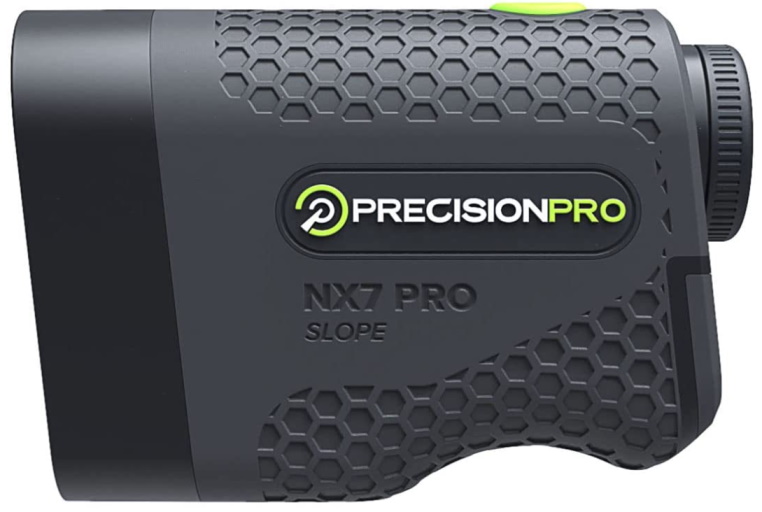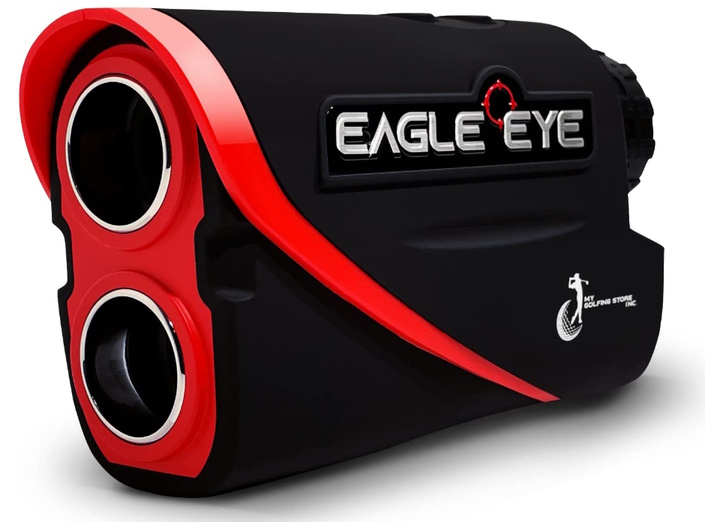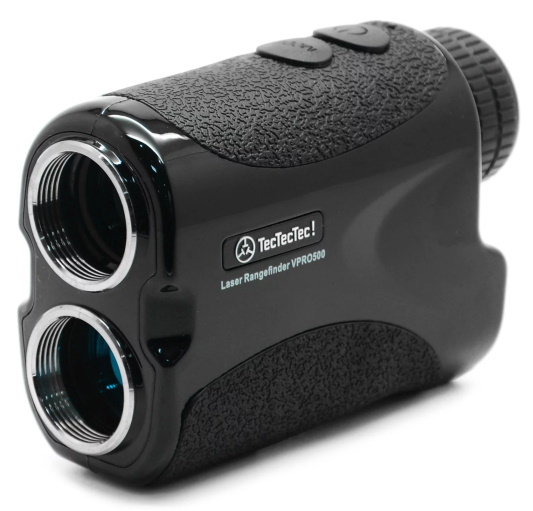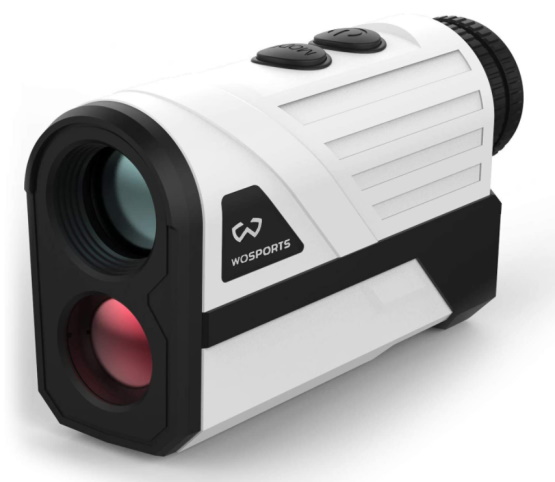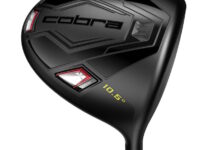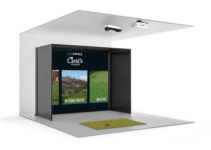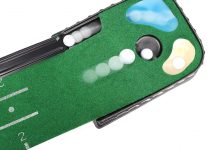Golfstead is reader-supported. When you buy through links on the site, we may earn an affiliate commission at no extra cost to you. Our affiliations include, but are not limited to, the eBay Partner Network and Amazon Associates.
A rangefinder allows you to accurately measure the distance to objects on a golf course such as hazards, greens and pins. This, in turn, enables you to determine the best club to hit and how full of a swing you should take to get your ball as close to the target as possible.
Proper use of a golf rangefinder will lead to better distance control, and ultimately, better scores. It also makes life easier during your rounds.
We understand that not everyone can afford high-end rangefinders that have steep price tags. Fortunately, there are many affordable options out there that can lock onto the flag, have good magnification and optics, and can even compensate for slope.
But because of the large number of options, it can be difficult to figure out which model you should go for.
If you’re looking to buy a rangefinder for golf with a $200 budget, you’ve come to the right place. In this guide, we’ll review and compare our picks for the best golf rangefinders under $200 across a range of different price points.
Note: Golfstead has tested and/or conducted in-depth research into all of the products featured in this guide. Our editorial process for these rankings takes into account a mix of many factors which may include performance, reliability, usability, value for money, cost, and the general consensus from other users of the product. The list that follows may be reassessed or updated over time.
Our Top Picks For Golf Rangefinders Under $200
Based on our own testing, research, and experience, here are our top selections:
- Callaway 300 Pro Laser Rangefinder
- TecTecTec KLYR Laser Rangefinder
- Precision Pro NX7 Pro Slope Rangefinder
- MGS Eagle Eye Gen 3 Laser Rangefinder
- TecTecTec VPRO500 Golf Rangefinder
- Wosports H-100 Golf Laser Rangefinder
1. Callaway 300 Pro Laser Rangefinder
When you think of the best golf rangefinder brands, Callaway might not cross your mind. But it turns out that they make some of the best rangefinders on the market. The 300 Pro is one of their most successful models, selling like hot cakes year after year.
The latest iteration of the 300 Pro offers several improvements including flag-locking and magnetic mounting for securing the unit to your cart frame. It also has a togglable slope mode.
Features
The latest version of the Callaway 300 Pro is lighter and more compact than its predecessor, with a weight of 0.34 pounds and a size of 2.7″ x 4″ x 1.4″.
A new feature of the 300 Pro is Pin Acquisition Technology (P.A.T. for short) with Pulse, which delivers a quick vibrating burst to confirm that you’ve locked onto the flag.
The next standout feature of the 300 Pro is Magnahold — this is a strong integrated magnet that can be used to secure the rangefinder to the cart frame.
The Callaway 300 Pro rangefinder has slope capability, which automatically adjusts distances for elevation changes. This mode can be turned off at any time so that it can be used legally in tournaments.
There is also a scanning mode that allows you to retrieve distances to multiple targets.
- Weight: 0.34 pounds
- Range: 5-1000 yards
- Magnification: 6x
- Accuracy: Within 1 yard
- Tournament Legality: Legal with Slope Mode turned off
Pros
- terrific value for money
- packed with useful features like slope, magnetic mounting, and flag vibrations
- great accuracy
- resistant to rain and fog
- targeting is very easy and quick
- small form factor
Cons
- build quality and optics are good but not top-of-the-line
- not rechargeable
2. TecTecTec KLYR Laser Rangefinder
The KLYR is a brand new laser rangefinder offering by TecTecTec that perfectly accommodates a $200 budget. It’s marked by a modern, pocket-sized design, matte finish, and versatile features such as a built-in magnet and belt clip.
The reviews that have come out so far for the KLYR are stellar, earning near-perfect ratings by most critics.
The KLYR is meant to be an upgrade to TecTecTec’s massively popular VPRO500 rangefinder, packing features such as Target Lock and slope mode.
Features
The TecTecTec KLYR is compact, coming in at about 30% smaller than the average rangefinder. It has a continuous scan mode for measuring distances to bunkers, hazards, and other points on the course.
The KLYR also has a Target Lock feature, which involves pressing and holding the Power button and slowly moving the aim over the flag from an object behind the flag. The rangefinder will lock onto the flag and display the yardage.
There is also a slope mode that compensates for uphill or downhill shots; this can be toggled off for legal tournament play.
Another feature of the KLYR is a built-in neodymium magnet that allows for attaching to any metal surface.
Included is a special belt clip that works with the KLYR’s magnet, allowing you to wear the rangefinder on your belt for quick access. Also included are a magnetic ball marker, battery, and premium water-resistant case.
- Weight: 1.1 pounds
- Range: 800 yards
- Magnification: 6x
- Accuracy: Within 1 yard
- Tournament Legality: Legal with Slope Mode turned off
The KLYR rangefinder is one of the best value rangefinders you can get for $200 or less.
Pros
- highly accurate
- fast operation
- stylish
- impressive optics considering the price
- has all the fixings including slope, target lock and magnetic mounting
- compact and comfortable in the hands
Cons
- plastic shell feels a little cheap
- magnet could be stronger
- small exit pupil
3. Precision Pro NX7 Pro Slope Rangefinder
The NX7 Pro rangefinder has less range and lacks a built-in cart magnet compared to Precision Pro’s NX9 model, but it’s an ideal option for golfers with a $200 budget that provides amazing value for the cost.
It’s an extremely popular rangefinder, boasting high customer scores on the Precision Pro store. It’s marked by a new ergonomic redesign, Pro Slope technology, high accuracy, clear optics, and flag lock with pulse vibration.
Features
The NX7 Pro Slope has pretty much all the features you would expect from a quality rangefinder. First, Pulse Vibration ensures that the measured distance on the enhanced LCD display is the correct one, and the unit is quick to lock onto targets.
The rangefinder also has an adaptive slope mode that determines the correct distance on uphill and downhill shots. This mode can be switched off for tournament play.
Overall, the features of the NX7 Pro work extremely well.
- Weight: 0.8 pounds
- Range: 650 yards
- Magnification: 6x
- Accuracy: Within 1 yard
- Tournament Legality: Legal with Slope Mode turned off
The NX7 Pro has a water-resistant design built to withstand rain and other weather. It comes with a carrying case, lint-free cloth, and pre-installed battery that can be replaced for free.
Pros
- easy to aim, even for those with shaky hands
- lightweight and feels good in the hands
- picks up objects quickly and easily
- user-friendly design
- excellent accuracy
- quality carrying case
Cons
- range is quite low
- short eye relief is not ideal for those who wear glasses
4. MGS Eagle Eye Gen 3 Laser Rangefinder
My Golfing Store (MGS) is an Illinois-based company that offers rangefinders, training aids, and online coaching programs.
Their Eagle Eye Gen 3 rangefinder is very popular and highly rated; in fact, you’d be hard-pressed to find the performance it delivers at such an affordable price.
Features
The MGS Eagle Eye Gen 3 sports a clear HD easy-read display and multi-coated optics. It has three modes of operation: continuous scanning, golf, and speed measurement.
The golf mode provides flag locking with vibration and indicates the straight-line distance along with the slope-adjusted distance on the display. Quick target acquisition is enabled by a precise pin sensor.
- Weight: 0.75 pounds
- Range: 800 yards
- Magnification: 6x
- Accuracy: 99.9%
- Tournament Legality: Legal with Slope Mode turned off
The Eagle Eye Gen 3 has a red and black colour scheme. It’s durable, resistant to dust and water, and requires no configuration out of the box — just grab it and start ranging. Included in the package is a microfiber cleaning cloth, battery, strap, and branded carrying pouch.
Pros
- relatively simple and easy to use
- lightweight
- accuracy is comparable to top-of-the-line units
- striking colour scheme
- great value for money
- continuous scanning and speed modes are always appreciated
Cons
- no slope toggle
- no magnet for mounting
5. TecTecTec VPRO500 Golf Rangefinder
The VPRO500 is TecTecTec’s time-tested and proven rangefinder. It is considered one of the best budget-friendly rangefinders on the market and is incredibly popular.
The VPRO500 is packed with value. It has been a top-selling rangefinder for many years and is very versatile with continuous scanning, first-target priority, Pinsensor technology, diopter adjustment, and more.
In addition, TecTecTec is a family-owned and operated company with excellent customer support.
Features
The VPRO500 utilizes Pinsensor technology to accurately measure the distance to a flagstick, even when it’s surrounded by background objects such as trees.
Beyond this, the rangefinder can run on the following three modes:
- Normal Mode: finds distances to objects of your choice; best for general use when other modes aren’t needed.
- Scan Mode: calculates distances to terrain in a continuous manner; best for finding multiple distances to hazards or other terrain other than the flagstick.
- Pin Mode: accurately measures the distance to any pin; best when the pin is farther away or has a wooded area in the background.
The VPRO500 has clear, multi-layered optics, a read-through-the-lens display, and diopter adjustment to accommodate those who are nearsighted or farsighted. It has a tough, durable body that is resistant to both water and dust.
- Weight: 0.41 pounds
- Range: Up to 540 yards
- Magnification: 6x
- Accuracy: Within 1 yard
- Tournament Legality: Legal
Note that because the rangefinder is black, it tends to camouflage well in most bags and can be difficult to find quickly. A red silicone cover is available that will solve this issue. A slope model, the VPRO500S, is also available.
Pros
- very affordable
- great reliability and accuracy
- performance is comparable to much more expensive units
- comes with a money-back guarantee
- feels good in the hands
Cons
- durability is lacking
- often fails after a few years
6. Wosports H-100 Golf Laser Rangefinder
At just a hair over $100, the Wosports H-100 is a very popular rangefinder model that is packed with value.
It offers slope-adjusted readings, flag locking with vibration, continuous range readings, angle measurement, and even speed measurements.
Features
Let’s go through each of the four modes of the Wosports H-100 rangefinder:
- Scan Mode: obtain slope-adjusted distance readings and angle readings to any point by holding down the Power button.
- Flag Lock Mode: press the Power button while aiming around the flag to lock onto it with a vibration. The LCD display will show the actual distance to the flag.
- Flag Lock Slope Mode: same as the above mode, except the LCD display will show the slope-compensated distance to the flag.
- Speed Mode: press the Power button to measure the speed of moving objects.
With the H-100, you can switch the units of measurement between meters and yards by pressing and holding the MODE button. The rangefinder has the ability to separate the flagstick from background objects.
- Weight: 0.37 pounds
- Range: 5-650 yards
- Magnification: 6x
- Accuracy: Within 1 yard
- Tournament Legality: Legal with slope mode turned off
The diopter is adjustable, and the battery cover is inseparable from the rangefinder so you don’t have to worry about losing it.
The Wosports H-100 is outstanding for the price, but compared to more expensive rangefinders, we find that it has less clear optics and locking on to the flag is a little more difficult.
Pros
- impressive accuracy
- easy to use
- nice design
- has slope capability
- has a lock-on indicator
- customer support is very accommodating
Cons
- quality of the case is so-so
- optics could be clearer
- locking onto the flag tends to be more difficult compared to pricier rangefinders
Buying Guide
There are many rangefinders on the market, and knowing which one to choose isn’t necessarily easy, especially if you don’t know anything about rangefinders. This guide will provide you with the rangefinder education you need in that regard.
Remember the essential purpose of a rangefinder: measuring the distance to the flagstick when hitting your next shot into the green. Any other features are greatly appreciated but are merely a bonus.
While it’s nice to hold and feel a rangefinder beforehand, the advantage of shopping for a rangefinder online is that it’s much more convenient to compare specs and technologies for different models.
If you want to find the right golf rangefinder for under $200, here are the most important factors to consider:
1. Accuracy
This is really the name of the game when it comes to golf rangefinders. Ultimately, high accuracy will remove guesswork from your game and improve your club selection.
When you’re measuring the distance to a flagstick, hazard, or any other feature on the golf course, you want the reading to be as accurate as possible. Depending on your skill level, a margin of error of just a couple yards can be the difference between a birdie and a double bogey.
The accuracy to look for in a rangefinder is ±1 yard; we recommend staying away from accuracy ratings worse than this, regardless of your handicap. Fortunately, even affordable rangefinders have accuracies of one yard and sometimes even better than that.
2. Display

The view through the sight can make or break a rangefinder. In a perfect world, you want:
- clear, bright optics
- a magnification of at least 5x
- a display that is easy to read when contrasted with the background image
- a diopter adjustment to ensure crisp images
Ideally, you want to go for a rangefinder that checks as many of these boxes as possible. It turns out that all of the rangefinders featured on this page have a 6x magnification.
A quality display will help you a great deal in locking onto the flag and locating other landmarks, especially when you’re playing in sunny conditions.
3. Durability
There are a few things to consider when it comes to durability.
First, does the rangefinder come with a carrying case or protective case? If a protective case is available, we recommend using it at all times during your round, and you should also consider putting the unit in its case after each use for maximum protection.
Second, does the rangefinder feel substantial? Super-light rangefinders may sound nice, but they are more prone to wear and tear and also more difficult to keep steady when pointing at targets. We think a weight of 0.5 lbs is a nice sweet spot.
Third, is the rangefinder water or moisture-resistant? If you’re playing in a light drizzle, this will keep your unit safe, and fortunately, most modern rangefinders are. Rangefinders can be resistant to dust as well.
Rangefinders usually end up being one of your most heavily used bag items after your golf ball, so it’s important for it to be able to hold up to years of use.
4. Battery Life

It’s also worth taking note of the battery a rangefinder uses. In particular, how long does the battery last on a charge, is it rechargeable, and how many charge cycles is it good for?
Nearly all golf rangefinders these days run on CR2 batteries, which can last 6-12 months.
Some CR2 batteries are rechargeable, lasting hundreds of cycles, but regular ones are not very expensive; you might as well buy a pack (get a great deal on Amazon) and keep one in your bag just in case.
Try to avoid rangefinders that require an unusual type of battery that is overly expensive or difficult to find.
5. Slope Capability
If you’re playing golf recreationally and want to use a rangefinder, we strongly recommend one with slope adjustment. This will determine the elevation change from your position to the flagstick and generate an adjusted distance reading that takes that slope into account.
This is based off the idea that when the target is at a higher elevation, the arc of the ball flight will be shortened and more distance will be necessary, while when the target is at a lower elevation, the arc will be lengthened and less distance will be necessary.
The difference in price between slope and non-slope models tends to be around $50. If you can afford it, it’s definitely worth it. And fortunately, it’s easy to find a slope rangefinder that costs $200 or less.
If you play without a slope rangefinder, you’ll have to compensate for elevation changes yourself through feel or by using rules of thumb.
If you also play tournaments, you can just toggle off the slope feature on most rangefinders so that it can be used legally. Watch out for rangefinders that don’t have a toggle and thus are not tournament legal.
6. Range

Every rangefinder has a range of distances at which it can produce accurate readings. Outside this range, the rangefinder may produce inaccurate readings or no readings at all.
Some rangefinders boast ranges of 1000 yards or more, but while that sounds cool, it’s really not useful in a practical sense and is a bit of a gimmick.
This is because you shouldn’t ever need to measure a distance that is less than how far you’ll hit your next shot. Unless you’re a long-drive golfer, this shouldn’t be much more than 300 yards.
Almost every rangefinder has a range of at least 400 yards, which will take care of pretty much every situation you’ll face on the course. This is why, while the range of a rangefinder is something to look at, it’s one of the least important factors.
7. Price

You might not want to spend more than $200 for your rangefinder, and that’s perfectly fine.
But would you be willing to spend less than $100 on what are considered “bottom-of-the-barrel” rangefinders? Would you spend $100-$200 on better models? How close to $200 are you willing to go?
Rangefinders tend to be cheap for a reason: they may be less accurate, have a cheap construction, have poorer optics, lack flag pulses, have less range or magnification, or something else.
In this guide, we’ve tried to include quality rangefinders over a range of prices under the $200 mark. But even for something like a rangefinder, you may be able to access financing for your purchase.
Conclusion
Eyeballing it out on the golf course will only get you so far. If you’re serious about developing your distance control and improving your scores, a rangefinder will be one of the most important accessories in your bag.
A rangefinder that costs $200 or less can be a huge boon to your golfing toolkit. And finding one that does its job reliably is actually pretty easy if you know what you want.
Each of the rangefinder models listed above deliver exceptional performance for the cost. We’ve given you the information you need; now it’s up to you to determine which one suits your needs and which one you prefer the most.
It’s also very beneficial to read customer reviews to acquire some useful insights as to how rangefinders actually perform. This will help you a great deal in the decision-making process.
Thanks for reading this guide. Which rangefinder models under $200 are you interested in? Do you have any questions? Feel free to leave a comment down below.



